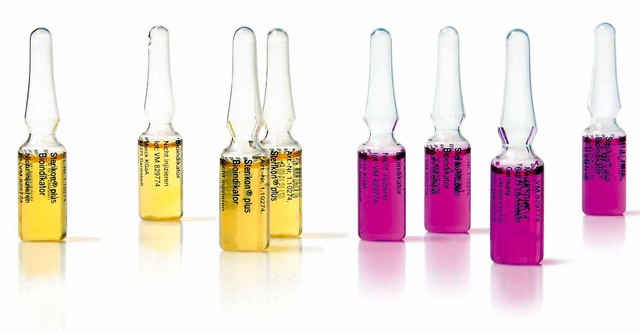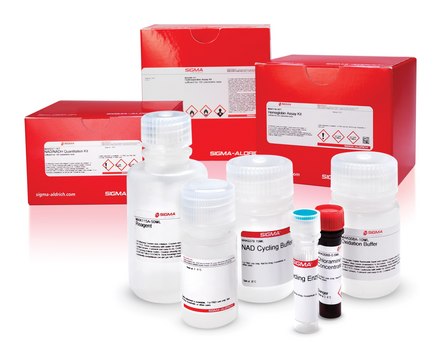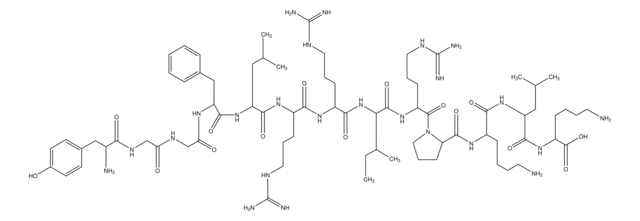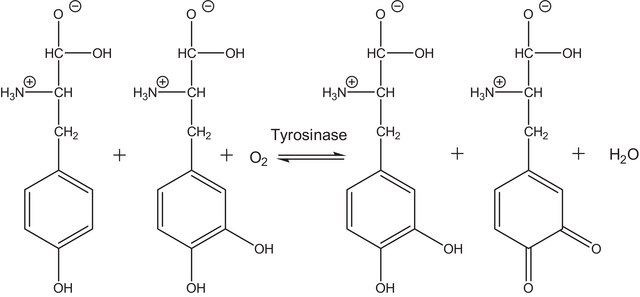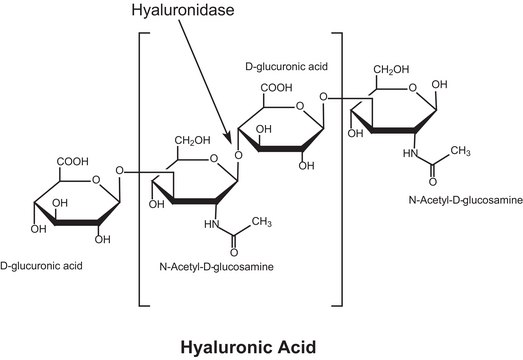MAB5276
Anti-Endorphin β Antibody, clone 3-E7
clone 3-E7, Chemicon®, from mouse
Synonym(s):
Anti-ACTH
Sign Into View Organizational & Contract Pricing
Select a Size
All Photos(1)
Select a Size
Change View
About This Item
UNSPSC Code:
12352203
eCl@ss:
32160702
NACRES:
NA.41
Recommended Products
biological source
mouse
Quality Level
antibody form
purified immunoglobulin
antibody product type
primary antibodies
clone
3-E7, monoclonal
species reactivity
pig, human
manufacturer/tradename
Chemicon®
technique(s)
ELISA: suitable
immunohistochemistry: suitable
isotype
IgG2a
NCBI accession no.
Specificity
The antibody reacts with the amino terminal H-Tyr-Gly-Gly-Phe sequence of human O-endorphin. Therefore, a high cross-reactivity with homologues of identical sequence, such as [Met]-enkephalin and [Leu]-enkephalin and a number of opioid peptides, occurs; the antibody also reacts with swine and camel O-endorphin. However, the antibody does not recognize human beta-lipotropin and N-acetyl-beta-endorphin (Gramsch et al., 1983; Meo et al., 1983; Herz et al., 1982).
Immunogen
Synthetic human beta-endorphin coupled with poly-lysine or thyroglobulin (Gramsch et al., 1983; Meo et al., 1983) (H-Tyr-Gly-Gly-Phe sequence).
Application
ELISA Immunohistochemistry
Optimal working dilutions must be determined by end user.
Optimal working dilutions must be determined by end user.
Research Category
Neuroscience
Neuroscience
Research Sub Category
Neuroinflammation & Pain
Hormones & Receptors
Neuroinflammation & Pain
Hormones & Receptors
This Anti-Endorphin Antibody, β, clone 3-E7 is validated for use in ELISA, IH for the detection of Endorphin.
Physical form
Format: Purified
Purified immunoglobulin. Liquid in 0.02M Phosphate buffer with 0.25M NaCl and 0.1% sodium azide.
Storage and Stability
Maintain at 2-8°C in undiluted aliquots for up to 6 months.
Other Notes
Concentration: Please refer to the Certificate of Analysis for the lot-specific concentration.
Legal Information
CHEMICON is a registered trademark of Merck KGaA, Darmstadt, Germany
Disclaimer
Unless otherwise stated in our catalog or other company documentation accompanying the product(s), our products are intended for research use only and are not to be used for any other purpose, which includes but is not limited to, unauthorized commercial uses, in vitro diagnostic uses, ex vivo or in vivo therapeutic uses or any type of consumption or application to humans or animals.
Not finding the right product?
Try our Product Selector Tool.
Storage Class
10 - Combustible liquids
wgk_germany
WGK 2
flash_point_f
Not applicable
flash_point_c
Not applicable
Certificates of Analysis (COA)
Search for Certificates of Analysis (COA) by entering the products Lot/Batch Number. Lot and Batch Numbers can be found on a product’s label following the words ‘Lot’ or ‘Batch’.
Already Own This Product?
Find documentation for the products that you have recently purchased in the Document Library.
Our team of scientists has experience in all areas of research including Life Science, Material Science, Chemical Synthesis, Chromatography, Analytical and many others.
Contact Technical Service
